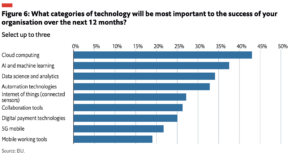We’ve just barely crossed the starting line of the new year and, naturally, the world of business wants to look to the future.
There’s a lot of utility in predicating purchasing behaviors and industry outcomes; you can be more responsive to client needs, able to quickly adopt burgeoning tech, and agilely navigate the effects of global events on your business.
We want to make this knowledge accessible to you. We’ve catalogued the IT industry trends for 2023 in this article.
Primarily powered by a report from the Economist Intelligence Unit (EIU), we’ll walk you through how global macroeconomics, new digital technologies, and generational shifts in the workplace are changing the face of IT.
Good or bad, this is an examination of what’s happening, and what’s expected to come in IT.
Spending Intentions: COVID, Climate, and Chips
COVID
COVID, and its impact on business, remains ever-present. Thankfully, we can now look backwards to the past two years and clearly see how the cultural impact of the virus has and will continue to shape businesses’ spending behaviors.
Foremost, the temporary has become permanent. What was once a necessary response has become business as usual; the work-from-home (WFH) movement has reshaped work permanently, and in doing so revealed our dependence on tech, as well as its shortcomings – particularly in IT infrastructure and support for remote workers.
COVID has led to clients and their employees demanding more of IT. Respondents to the Economist survey cite incomplete support of remote workers (72% of respondents), information integration across organization; or de-siloing data (69%), and implementing system changes more quickly (69%) as the primary points where IT needs to improve.
Climate
Additionally, extreme weather events, spurred by climate change, have business owners re-evaluating their technology – or lack thereof. Flooding, fires, weakened power grids, and unsafe commuting conditions are contributing to the reshaping of work culture and norms. Above all, they have exposed vulnerabilities in maintaining paper documents and legacy systems. For the first time, business owners that once resisted updating and adopting modern technologies are being forced to recognize their total potential, even beyond their utility to solve these problems. Cloud computing represents a future-proof solution to a myriad of your clients’ concerns; and you can expect to see an uptick in interest in those services as variants and disasters persist.
Since COVID, climate consciousness has been on the rise for consumers, and business owners are catching on to the value in marketing themselves as a “green” company; this is further evidenced by the electronic vehicle (EV) craze and EVs’ increasing market share. Clients will be seeking sustainable and energy efficient technologies and asking more questions about the manufacturing conditions of the products you’re offering.
Chips
While not mentioned in the report from the EIU, we think it’s important to briefly consider how tensions in the semiconductor industry may impact your product stack.
Semiconductors are a critical component in computing; they are in everything from laptops to smartphones to medical diagnostic equipment. What’s happening in that industry impacts everyone.
Because they are imperative to tech, the US government has applied extensive export controls to abate China’s ability to produce semiconductors, with the professed intention of inhibiting them from utilization in “sensitive technologies with military applications.” This move has resulted in a dip in China’s chip output and a trade dispute between the two countries; simultaneously, it has applied more pressure to other chip makers to produce higher-quality and a greater quantity of chips.
Presently, it’s unclear what the long-term effects of this economic-political tension will be, but it could lead to increased prices for semiconductors, as well as other countries to surpass China in chip exports.
The primary lesson offered here is that global macroeconomic conditions will continue to impact the focal points of business spending; you can anticipate where the point may shift to by keeping an eye on current events.
Solutions, or the Tech Your Clients Want
Organizations are increasingly reliant on technology for success. As mentioned above, global events are creating local concerns for business owners, and they’re looking to technology to provide solutions. Here’s where spending intentions and products collide in IT industry trends for 2023.
Digital Transformation
Digital transformation, meaning the integration of digital technologies into every facet of business, is a common response to organizational concerns of productivity and profitability. Clients will be seeking options for digitizing non-digital operations and services. Whether they’re looking to enable collaboration or protect data, gradual digitalization will overtake even the most tech-resistant of business owners.
Cloud Computing
Cloud computing delivers computing services via the internet, or “the cloud.” This includes servers, storage, databases, software, and intelligence. And businesses find cloud computing appealing for a number of reasons.
For starters, it’s scalable and flexible, allowing businesses to ‘go as they grow’ with subscription-based payment models. Clients consider the cloud as the solution to external disruptions and internal pivots. No longer will physical disasters imperil their digital assets. Additionally, it enables remote collaborations and cuts operating costs – two things of grave importance in recent years.
Clients looking to reduce costs and update legacy systems are prime candidates for cloud computing. With many vendors to choose from, IT businesses can cater to the niche needs of their customers.
AI
AI, or Artificial Intelligence, is poised to accelerate business success on every front. Intelligent products, drag-and-drop features, natural language processing, and the boundless other applications of AI will greatly improve productivity for organizations in every industry and augment the way people work. Ultimately, you’ll see complex tasks becoming accessible to workers with varying skill sets.
You’re probably already hearing the buzz around applications like ChatGPT, Midjourney, and Bard. They hint at a wealth of potential which stretches beyond mere business applications, and reaches far into the future of the quotidian minutiae of human life: it will change us and the way we live, profoundly. For now, natural language processing (NLS) can be leveraged to create everything from SEO articles to website code – making marketing easy for busy business owners.
What’s more, AI will drive sophisticated iterations of automation – a trend in its own right. Dubbed “new automation,” as the Industrial Revolution saw machines replacing minimally skill labor, computing machines will similarly supplant higher skilled labor. Self-driving trucks will eliminate our need for truckers, but other professions are susceptible too: healthcare workers, lawyers, and wealth advisors, for example.
For IT, this means tasks like endpoint management and remediation could be as simple as pressing a button.
While AI poses a threat to workers, business owners are positioned to reap the benefits of an algorithm-powered workforce. The most successful of them will, undoubtedly, be early adopters. Start anticipating conversations with customers around AI applications and how they can help them achieve success in their vertical.
The Battle Over Data
With internet natives Gen Z and Millennials matriculating more-and-more into the workforce, a tug of war in the ownership of data is commencing. This is expected to be an ongoing development and an IT industry trend for 2023.
Previously, IT has enjoyed complete ownership of employee data. As the EIU put it, IT was “the gatekeeper of corporate technology.” While it’s true that IT still owns and manages applications and systems, it’s also true that clients and their employees are more technologically empowered and feel a greater sense of ownership over their data.
Collaborating with Non-IT Teams
Non-IT teams frequently take the initiative to procure the applications they need for daily work despite unwittingly exposing systems and data to security vulnerabilities, and the statistics are striking. According to the EIU survey, more than half of respondents claim to “take the lead in procuring or developing most of the applications that they use,” and “75% of BDMs state that when procuring or creating new applications, they prefer to keep their data where it is rather than move it to new repositories that may be controlled by IT or outside vendors.”
This is in part a capacity issue. IT teams are overwhelmed with maintenance and infrastructure projects. Non-IT teams would rather beg for forgiveness than ask permission because IT is consumed with a backlog of work.
IT teams are in a new position. Rather than gatekeep tech, we encourage IT to adopt a collaborative approach with tech-savvy teams. Technology and business are deeply intertwined, and that trend will only become more pronounced in the future. Shifting strategies to account for, rather than resist, this tide is crucial for the overarching success of a business. Consider the utility of cross functional teams, to put the “why” and “how” behind the need for tech. This will not only legitimize tech procurement beyond IT but also give IT teams context to their co-workers and clients’ needs. Additionally, it will create space for better conversations around cybersafety and de-siloing data.
Extu Can Help
Enjoy this article on IT industry trends for 2023? At Extu, we’re more than marketing experts, we’re industry experts too. We help businesses stay on top with fully automated marketing campaigns featuring cutting-edge thought leadership content that demonstrates your mastery to your prospects. Best of all, our program is at no-cost to partners because our program is funded by sponsorships from the big tech vendors you know and love. For 10-minutes a month you can accelerate your lead generation efforts with our high-powered marketing and close more deals with sales enablement content such as this.




